In today’s article, I’ll discuss the 17 most fascinating Amazon Rainforest birds that you will want to see!
Fascinating Amazon Rainforest birds
With over 1,300 bird species, the Amazon Rainforest is a prime bird habitat with incredible animals, from eccentric to mesmerizing birds.
However, many of them are threatened by hunting and habitat loss, which are the main causes of their decreasing population numbers.
While researchers and ecologists try more than ever to save the bird communities in the region, I thought it would be a great idea to create awareness around some incredible Amazonian birds.
Let’s get to them!
1. Hyacinth macaw (Anodorhynchus hyacinthinus)
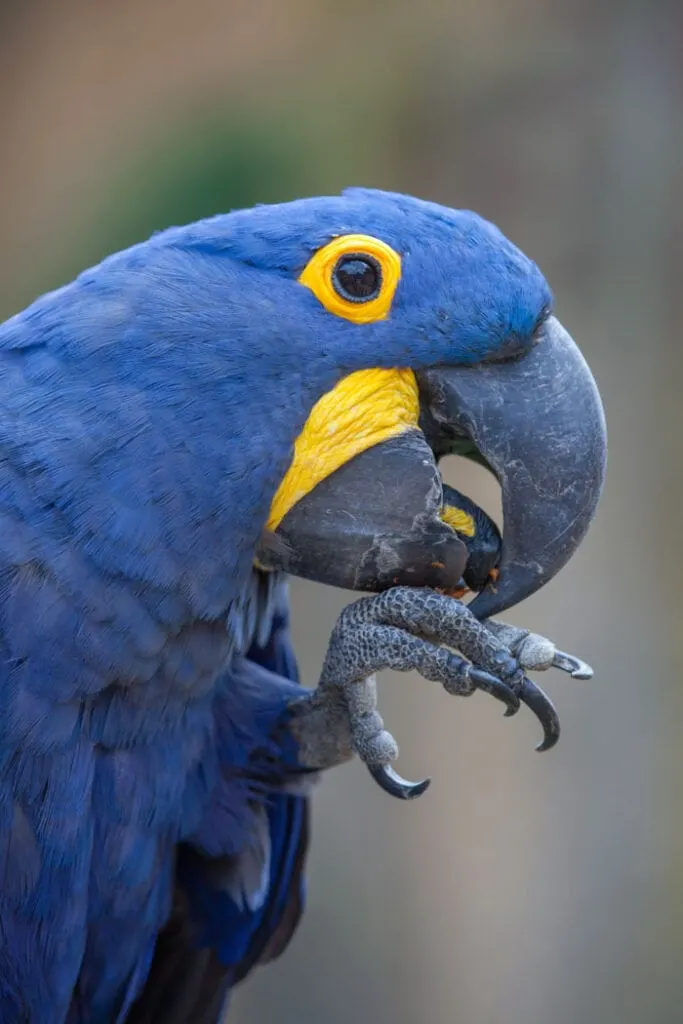
Hyacinth macaw is the world’s longest parrot and one of the prettiest Amazon birds. It has a wingspan of 4 to 5 feet (130 to 150 cm).
This majestic bird has impressive cobalt blue feathers, contrasting with their bare yellow eye-ring and the yellow patch of skin beside the lower bill. Its iris are dark-brown in color, and its feet are dark gray.
Females and males are nearly indistinguishable, but the females are typically a little more slender. On juveniles, the upper bill is paler, and the tail is shorter.
2. Toco toucan (Ramphastos toco)
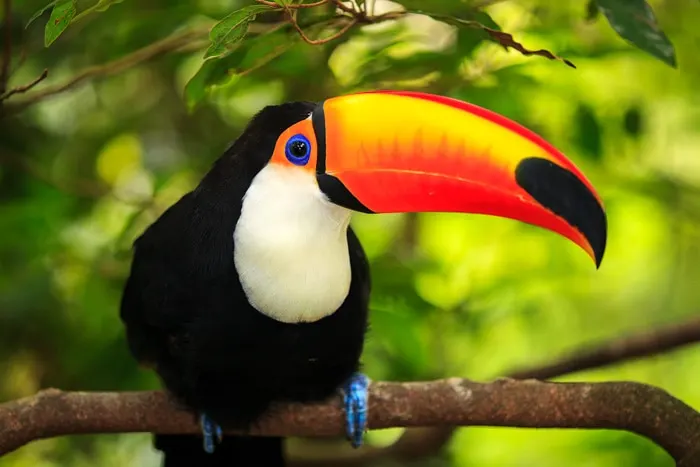
The toco toucan is the largest and best-known species in the toucan family, measuring 1.8 to 2 feet (55 to 65 cm), head to tail.
It has a striking plumage with a mainly black body, a white throat, chest and upper tail-coverts, and red under tail-coverts.
There is a blue skin around its eyes that appears to be a blue iris. This blue skin is surrounded by another ring of bare, orange skin.
However, this bird’s most noticeable feature is its colossal bill, which measures up to 9 inches (23 cm) in length; it is yellow-orange in color and with a black base and a large spot on the tip.
While it might look heavy, its bill is relatively light because the inside is mostly hollow.
The very flat tongue is nearly as long as the bill. The male and the female are similar in appearance, and juveniles are duller and shorter-billed than adults.
Amazon fact: The Amazon Rainforest is the most biodiverse region in the world.
3. Blue and yellow macaw (Ara ararauna)
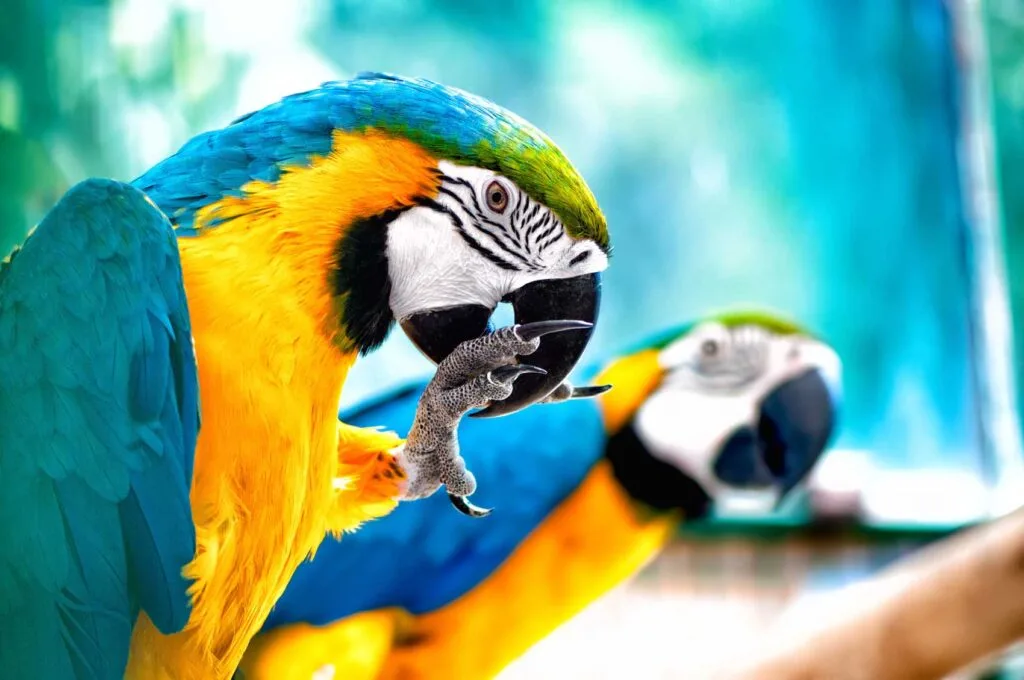
The blue-and-yellow macaw is named for its beautiful blue body with a dark lemon-yellow chest.
It has a black bill with a feathery black “beard” just below it. The crown is green.
Since part of this macaw’s face has no feathers, it blush pink when it gets excited.
This macaw forms close-knit groups in the wild. It is gregarious and will spend time together with others in their flock, playing, bathing, and hunting for edible fruit in the forest.
4. Scarlet macaw (Ara macao)
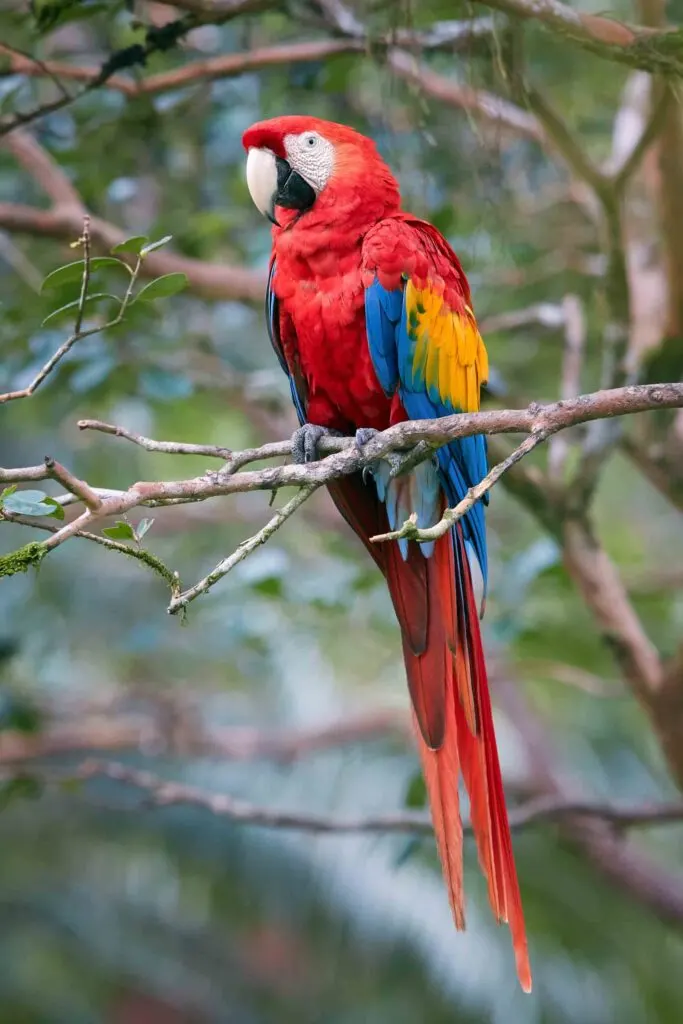
The very colorful scarlet macaw is a large Amazon parrot, measuring 2.6 feet (81 cm) in length.
Its plumage is predominantly scarlet, with bright blue feathers on the tail, rump, and wings.
The longer upper wing coverts are colored yellow, the upper sides of flight feathers on the wings are a dark blue, and so are the ends of their tail feathers.
This Amazon bird has bare white skin surrounding its eyes and beak. Their upper beak is mostly pale, while the lower is black.
Males and females look the same, and the only difference between young birds and adults is that the former have dark eyes while the latter have light yellow eyes.
5. Spectacled owl (Pulsatrix perspicillata)
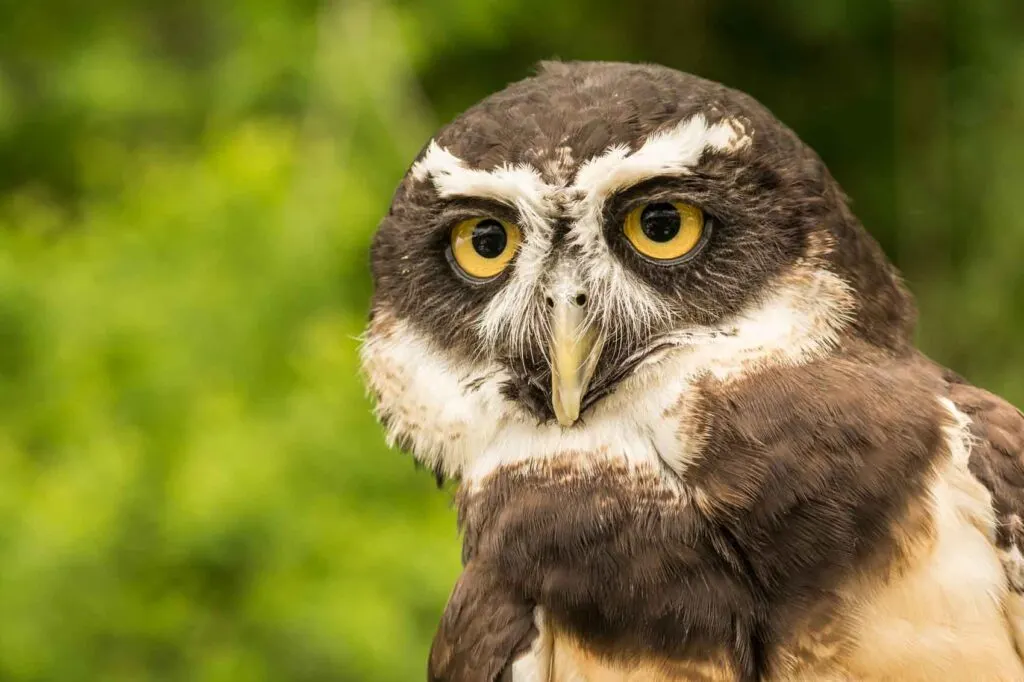
The spectacled owl is a large tropical owl species.
It is unmistakable in most of its range with blackish-brown upperparts, head and upper breast, white facial markings, and whitish to yellowish-ochre underparts.
The eyes are yellow, and the beak is pale. The juvenile is even more distinctive than the adult, having a snow-white body apart from a chocolate brown facial disc.
It is the only owl species known to permanently inhabit the rainforests of the Amazon basin.
6. Hoatzin (Opisthocomus hoazin)
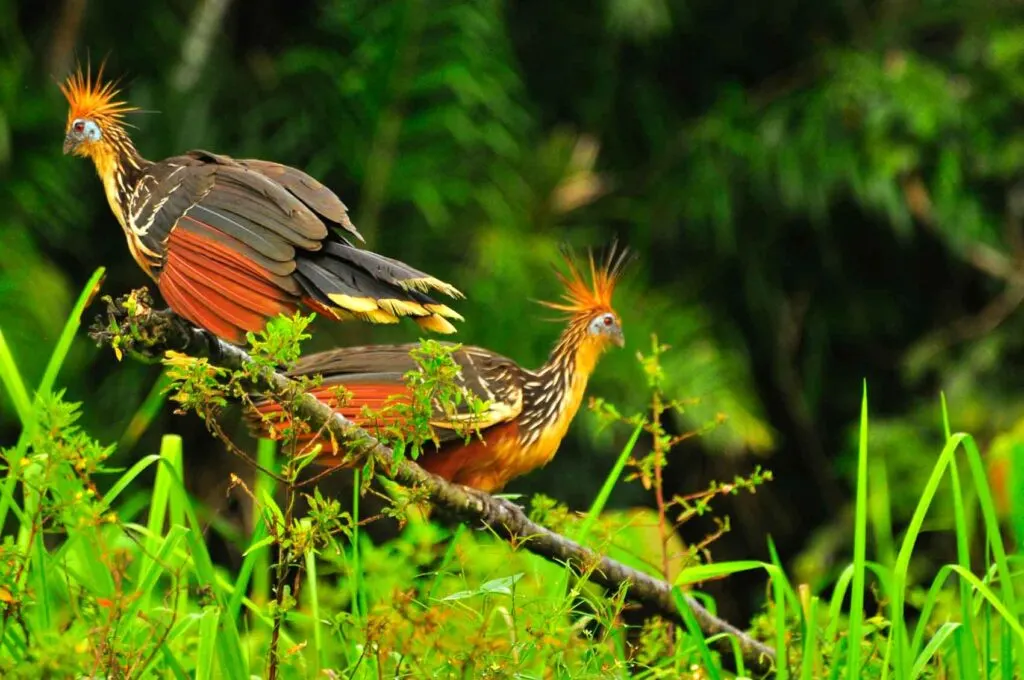
Hoatzin is a Neotropical Amazon bird, native to South America and usually found at the Orinoco basins. It lives in riverine areas like mangroves, lakes, swamps, etc.
It isn’t a fantastic flier but is known to rise from tree to tree and can stay continuously in the same place unless perturbed by a loud noise. Beyond that, it usually makes clumsy movements while along leafage.
On each of their wing digit are chicks with claws. Hoatzin belongs to the herbivores (folivores) group and feeds mainly on plant leaves that grow in their habitats.
7. Jabiru stork (Jabiru mycteria)
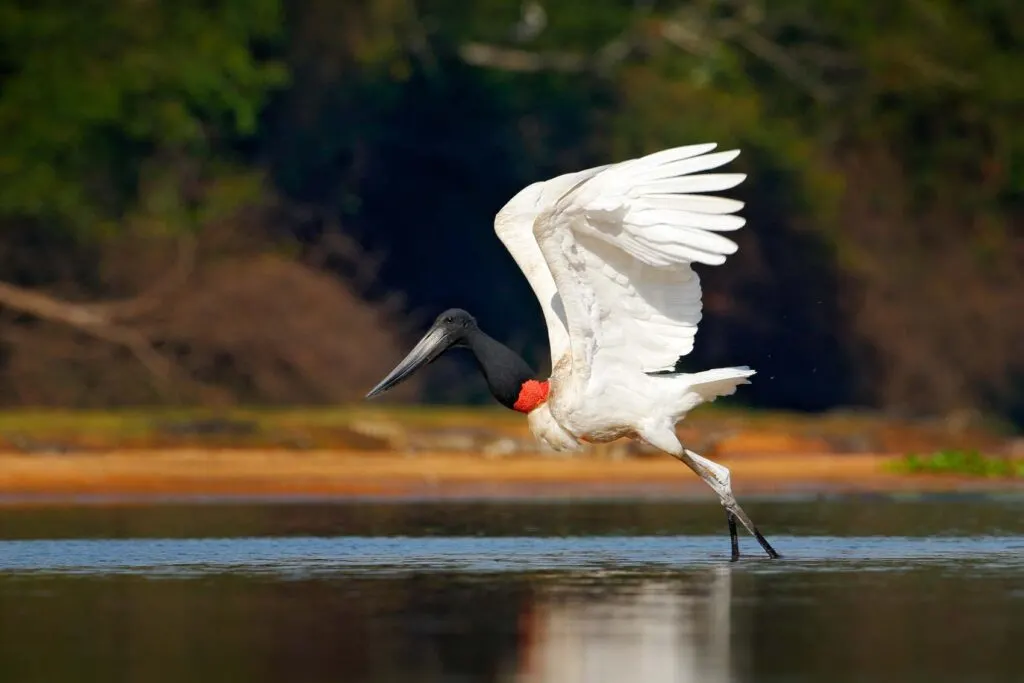
Jabiru is a tall, long-necked wading bird known for being one of the largest American flying birds. It can attain 4.5 feet in length and is mostly nestled in the wetland regions of Brazil.
Jabiru feeds majorly on aquatic animals such as fishes, amphibians, reptiles, etc. –they also feed on insects or small mammals.
During the dry season, they settle for carrion and dead fish. Jabiru is not a fast-moving bird; they tend to move slowly when hunting prey. Their wingspan is about 8 feet, with a sluggish flapping style – about 180 flaps per minute.
8. Laughing falcon (Herpetotheres cachinnans)
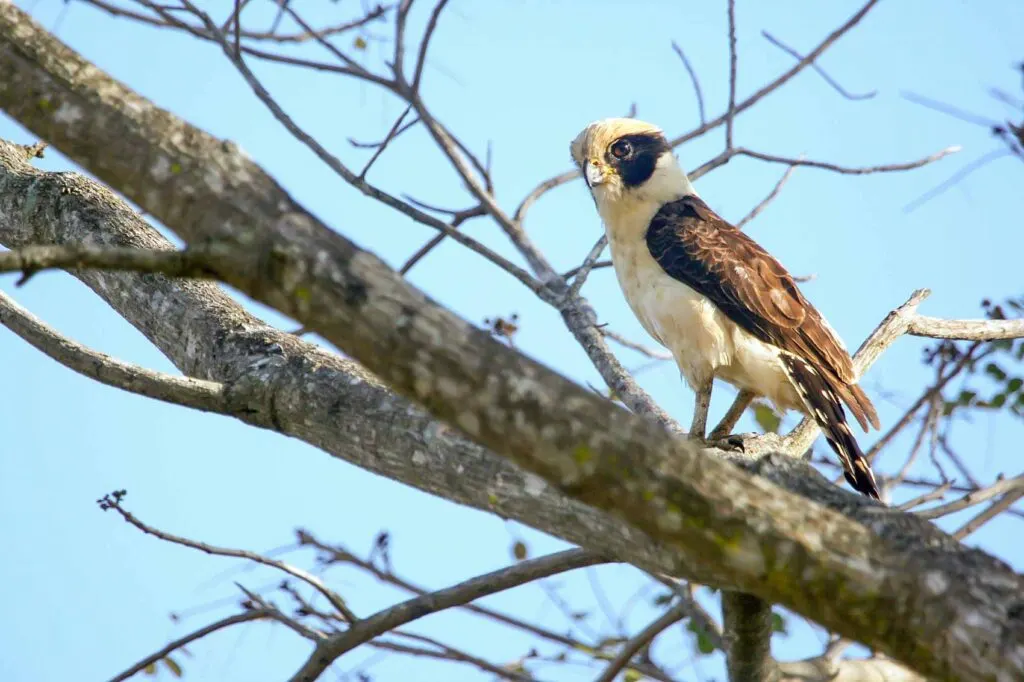
Laughing Falcon is a spectacular mid-sized raptor of tropical lowlands. They are skillful snake-eaters and known as the only members of the genus Herpetotheres.
These fascinating birds of prey are mostly seen around tall lifeless treetops, possessing a unique tone but lacks the potential to soar.
They often spend their time staying on a perch, sitting uprightly and starring intently on the ground, or nodding their tail. Laughing Falcon is relatively peaceful and is hardly a threat to small birds.
9. Great egret (Ardea alba egretta)
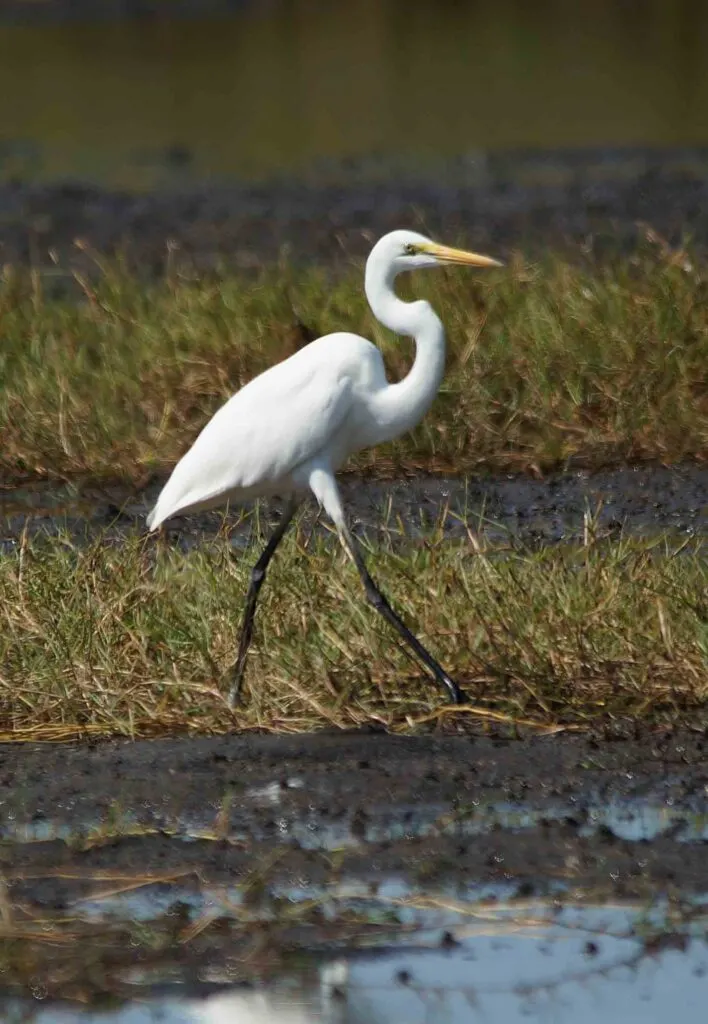
The great egret is a dazzling white heron with a long, sharp yellow bill, also known as large egret, or great white heron or great white egret, which appears to be svelter than a typical great blue Heron.
They equally have subspecies, which are habituated in Africa, America, South Europe, and Asia. This species is widely distributed and can socialize with other species.
They prefer to live in ponds, shores, marshes, mudflats and survive by picking fish, frogs, insects, reptiles, and some small mammals in shallow waters.
10. Spix’s guan (Penelope jacquacu)
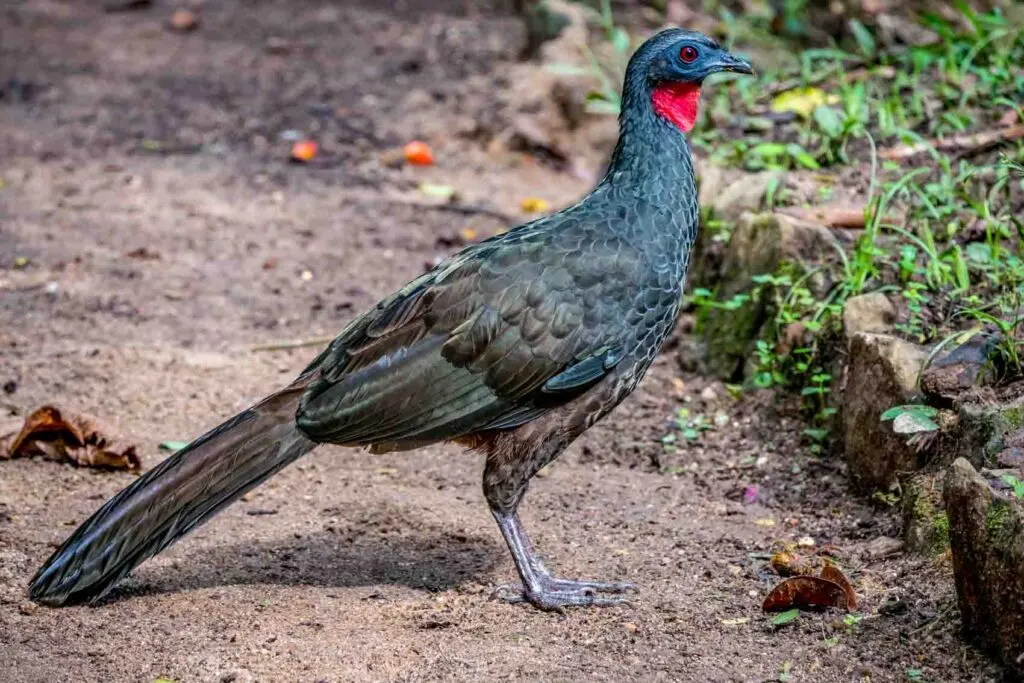
Spix’s guan is an arboreal bird belonging to the family of Cracidae and among the birds in the Amazon Rainforest.
They boast of a blue-ish or brown-ish dotted color and a sharp red dewlap –having the appearance, shape, and size of a turkey.
They dwell mainly on trees and are found at the Amazon basins in Colombia, Brazil, Peru, Ecuador, Bolivia, and Venezuela.
Beyond that, they are fruit eaters and reside in the humid regions of the tropical (lowland) forests.
11. Great potoo (Nyctibius grandis)
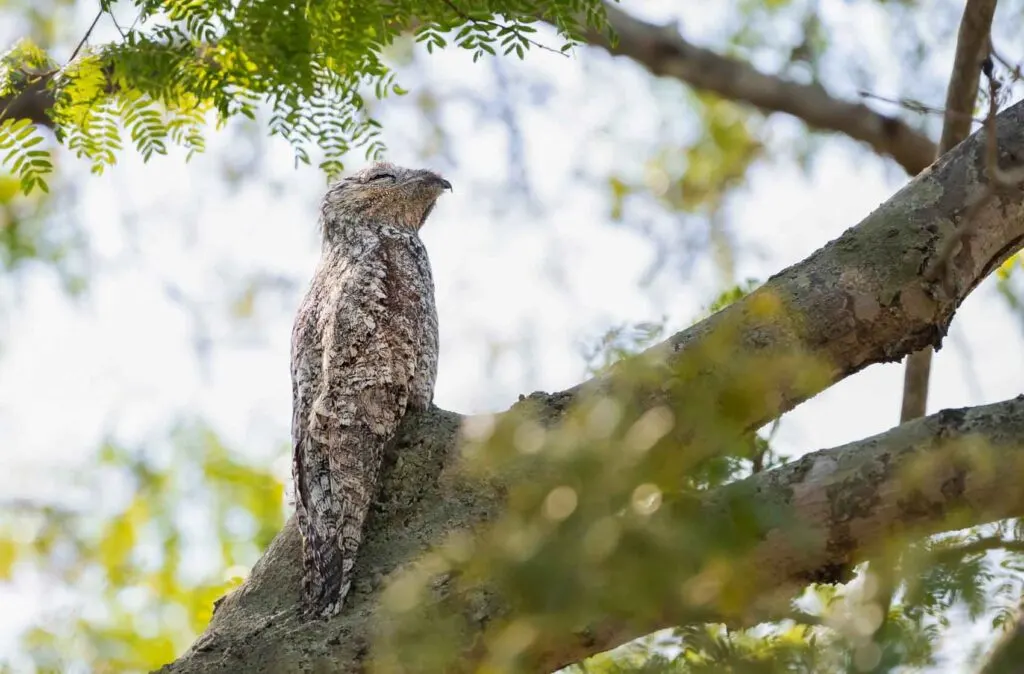
Amongst other eccentric birds in the rainforest is the great potoos.
Potoo is a passerine bird with exceptional camouflage ability; they are often hard to spot and are found sitting on a horizontal limb during the daytime. They possess excellent camouflage skills, but monkeys and bigger birds can prey on them.
Both the male and female Patoos nurture their egg till hatching. They feed primarily on beetles but sometimes hunt for termites, grasshoppers, insects, and moths.
12. Plum-throated cotinga (Cotinga maynana)
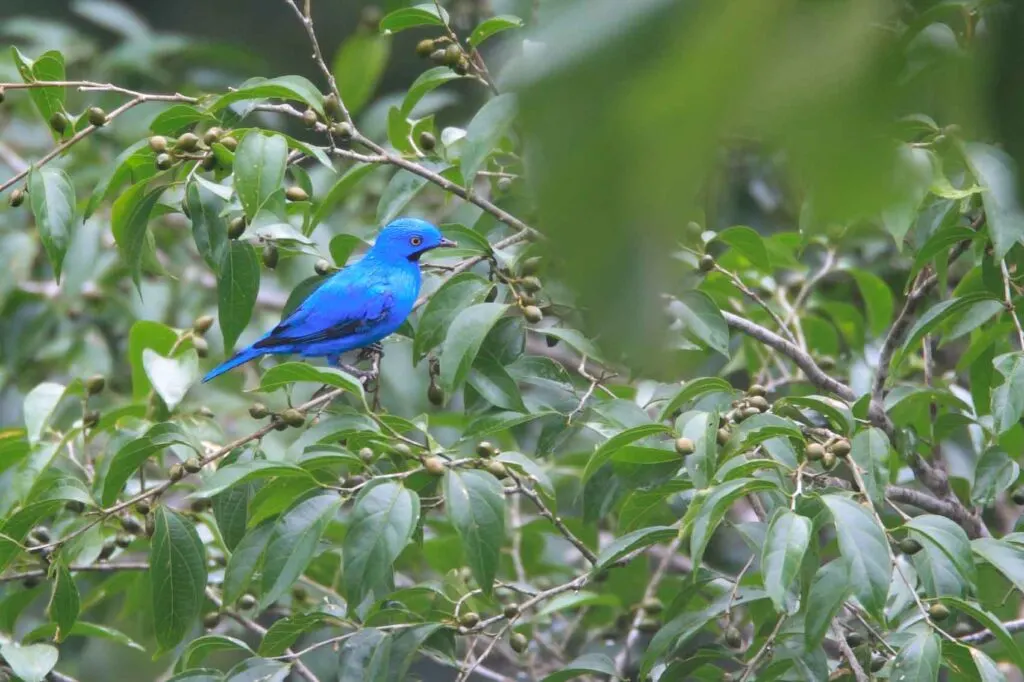
The plum-throated cotinga is one of the birds in Brazil, belonging to the Cotingidae family. They are also located in Bolivia, Colombia, Peru, and Ecuador.
The male has a turquoise blue color (without markings), a purple throat, and a slight yellow iris. The female has a dusky brown look and faint scalloping.
They survive by fruits and dwell mostly in past forests that were significantly degraded or in subtropical or tropical moist lowland forests.
They are known for echoing a soft and mournful “hoooo.” And can lie horizontally, shaking its feathers and spreading its tail.
13. Crimson topaz (Topaza pella)
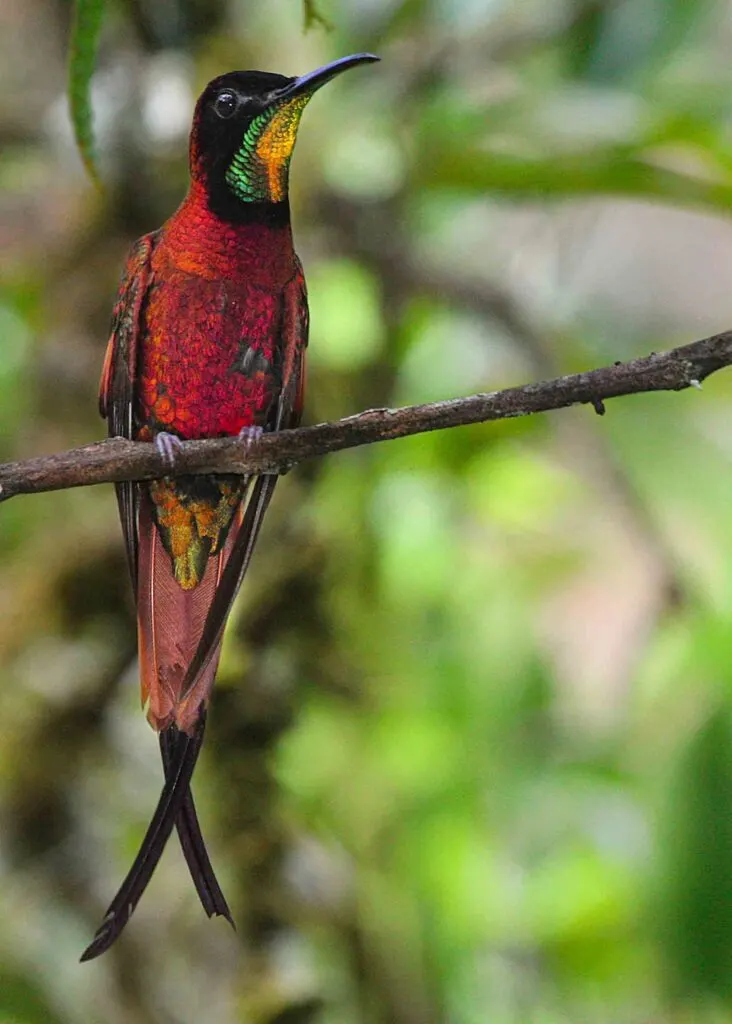
This charming hummingbird is one of the birds of the Amazon–with stunning rich feathers, a glittering green throat, and scythe-like tail streamers.
They belong to the non-migratory bird group, are categorized under the Trochilidés family, and resides in South America (Brazil, precisely).
They are famous for being the largest hummingbird in Brazil and second to the Giant Hummingbird in size.
They can feed on insects but are mostly caught foraging around low lands and picking flower nectars (nectars of flowers are their main diet).
14. Green oropendola (Psarocolius viridis)
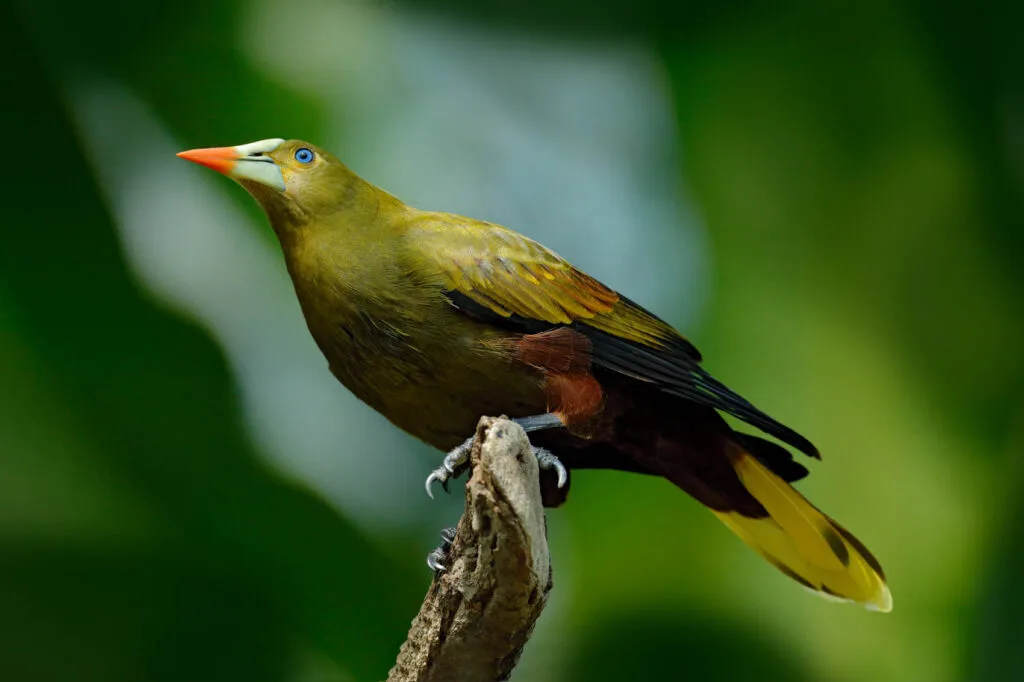
Green oropendola is a jungle bird that belongs to the Icteridae family. They fare better in a wooded environment and are mostly found in the Amazon basin of South America.
Insects, fruits, and nectar are their diet. They grow bright olive-yellow feathers and chestnut (brown) in the posterior underparts and rump.
Their bill is pale with an orange tip; they are also known as vocal birds and can create a wide range of songs.
15. Amazon kingfisher (Chloroceryle amazona)
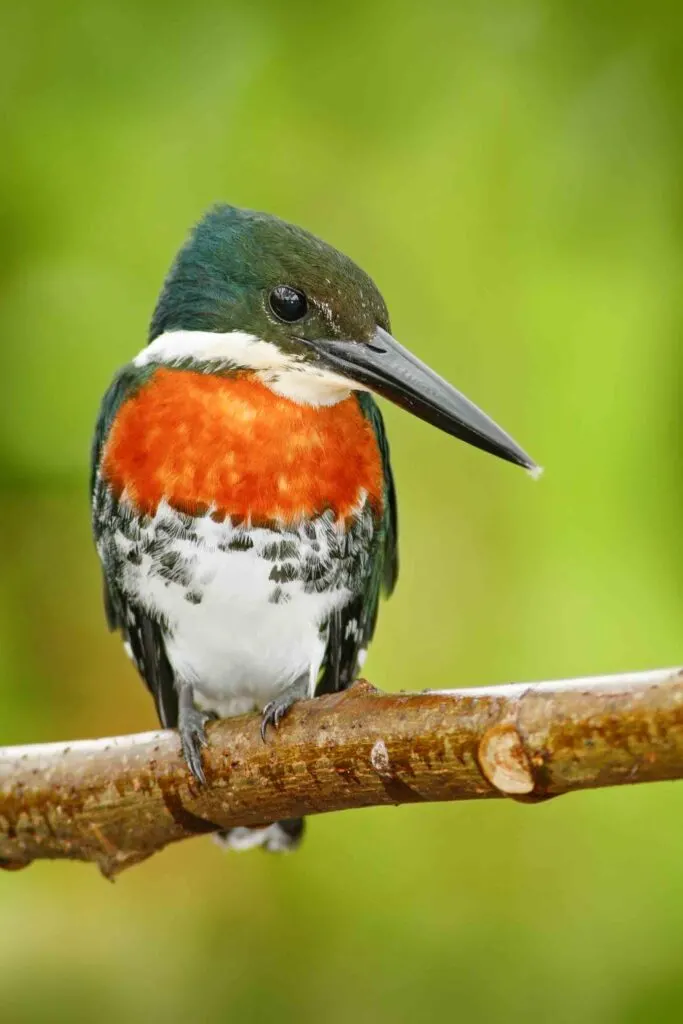
The Amazon kingfisher is a mid-sized bird of tropical lowlands, mostly found in the tropics from southern Mexico through northern Argentina.
They are seen around riverine areas like the edges of a lake or pond. Their body is decorated with dark blue or green feathers, with a shaggy crest, and a whitish collar located in their neck region.
They feed on insects and amphibians (like small reptiles and crustaceans). Amazon Kingfisher is a special jungle bird, gifted with a fantastic vision that can create clear distinctions among colors.
Their long, dagger-like pointed bill is made for seizing and impaling its prey. At the same time, their sturdy feet provide support and stability as they perch on tree branches or wires.
16. King vulture (Sarcoramphus papa)
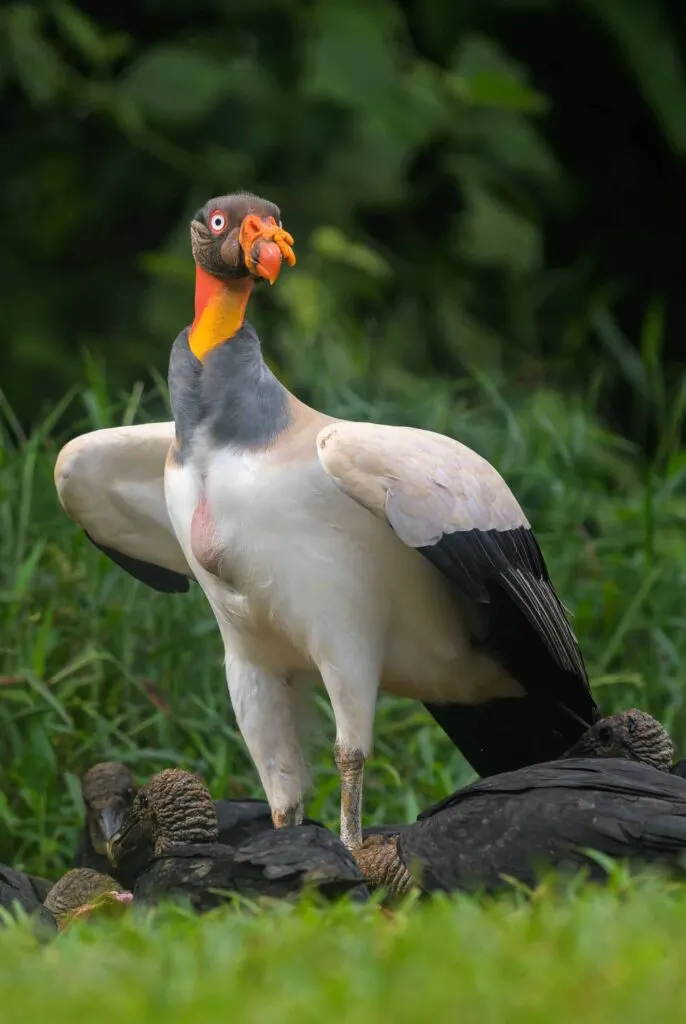
The king vulture is one of the tropical Amazon birds; they are of the Cathartidae, known as the New World Vulture family.
They are located in Central and South America and thrive mainly in tropical lowland forests (ranging from southern Mexico to northern Argentina).
Beyond that, they usually raid locations where they are available dead and rotten animals and overawe smaller vultures. Their thick claws grab and hold meats while the brawny beak tears the meat.
They possess a strong sense of smell and far sight and can travel a long distance searching for food.
17. Yellow-headed caracara (Milvago chimachima)
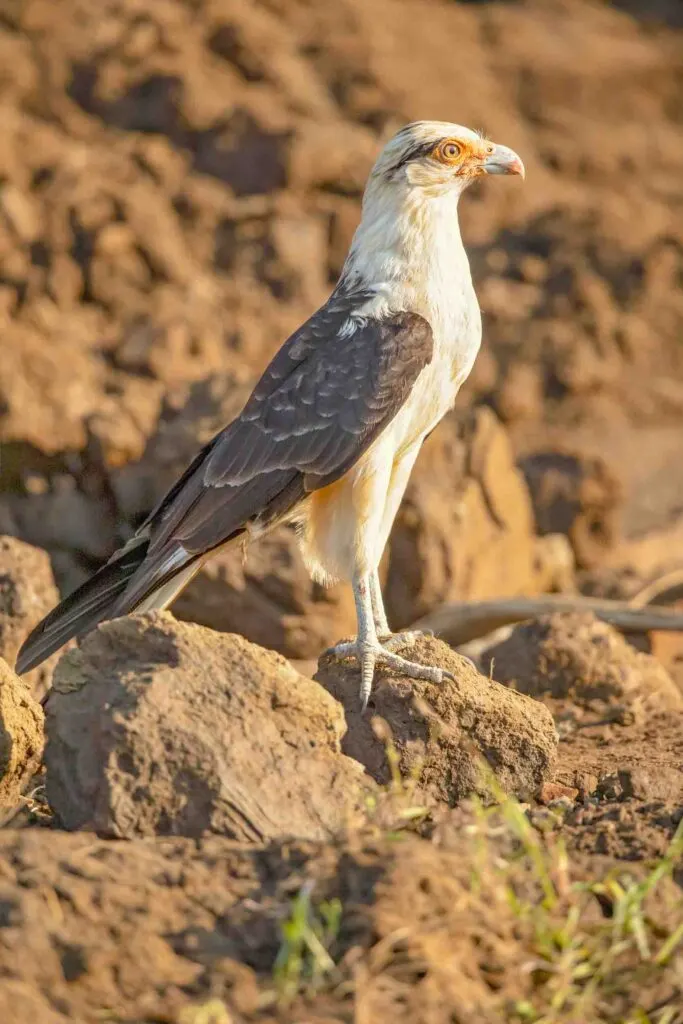
Amongst mystery birds in the rainforest is this beautiful yellow-headed caracara of the family Falconidae family.
This bird is famous for its deep call in the wild. Besides, they are nestled in the subtropical and tropical Southern regions of Central America and South America.
Unlike other falcon birds, it flies sluggishly when hunting and mostly picks food by scavenging. They feed on all kinds of things, like carrion, insects, maize, road-kills, amphibians, birds, fish, fruits of oil palms, and horse dung.
Their upperparts, wings, and backside have a blackish-brown look and a whitish patch at the inner part’s base. It’s fond of foraging around the ground and can playfully perch on cattle’s back to pick ticks or flesh from the cattle’s wounds.
Learn more about the Amazon Rainforest animals
To deepen your understanding of the wide range of animals in the Amazon Rainforest, you might want to browse my other articles where I talk about the spiders and mammals that live in this tropical forest.
But, if you want to learn more about other animals in Brazil, not only in the rainforest, you might want to check this guide I just linked above.
Did you like this post about the Amazon Rainforest birds? Then send it to a friend who would like it too!

Willard Nieboer
Friday 13th of August 2021
The birds of the Amazon rain forest are the most beautiful and interesting in the world. I spent some time with a college biology class on a houseboat on the Napo River in Ecuador, making daily and nightly excursions down smaller rivers and tributaries to study the flora and fauna. An experience I will never forget!
Bruna
Friday 13th of August 2021
What an incredible experience, Willard! I haven't seen many birds from the Amazon yet, so I can only dream of going on such an adventure. Thanks for sharing!